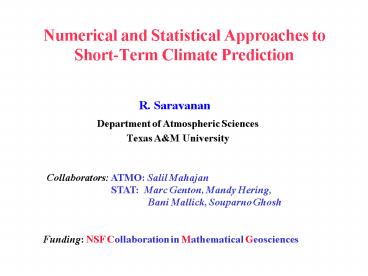Numerical and Statistical Approaches to ShortTerm Climate Prediction - PowerPoint PPT Presentation
1 / 31
Title:
Numerical and Statistical Approaches to ShortTerm Climate Prediction
Description:
Best measure of forecast skill? ... UK MetOffice. Typical statistical model for El Ni o prediction ... Predictability of the First Kind (weather prediction) ... – PowerPoint PPT presentation
Number of Views:146
Avg rating:3.0/5.0
Title: Numerical and Statistical Approaches to ShortTerm Climate Prediction
1
Numerical and Statistical Approaches to
Short-Term Climate Prediction
- R. Saravanan
- Department of Atmospheric Sciences
- Texas AM University
Collaborators ATMO Salil Mahajan
STAT Marc Genton, Mandy Hering,
Bani Mallick, Souparno Ghosh
Funding NSF Collaboration in Mathematical
Geosciences
2
Climate prediction
- Climate is what you expect.
- Weather is what you get!
- i.e., Climate is the expectation value of weather
- Short-term climate prediction
- Predicting seasons to years ahead
- Atlantic hurricane frequency, Sahel droughts, El
Niño, - Verifiable using 50-100 years of the instrumental
data record - Long-term climate prediction
- Predicting centuries ahead
- Climate change/global warming
- More appropriately termed climate projections,
- because of the need to model human behaviour
3
Hurricane frequency over time
4
El Niño Mechanism
5
NINO 3.4 index(Kaplan SST data set base period
1951-1980)
6
El Niño Teleconnections
7
Approaches short-term climate prediction
- Numerical/physical approach
- Numerically solve the physical equations
governing the climate system - Statistical/empirical approach
- Train a statistical model using available data
8
Typical numerical model for El Niño prediction
- Atmospheric Model
- 2.8 x 2.8 degree (300 km x 300 km) horizontal
grid - 26 vertical levels
- 20 minute time step
- Parameterizations of turbulence, mixing, clouds
etc. - Ocean Model
- 1 x 1 degree (100 km x 100 km) horizontal gid
- 25 vertical levels
- 1 hour time step
- Parameterizations of turbulence, boundary layers
etc. - Land Model
- Coupler to connect atmosphere, ocean, and land
9
Numerical simulation of sea surface
temperatures(Davey et al., 2002)
10
Typical statistical model for El Niño
prediction(Xue et al. 2000)
11
(No Transcript)
12
Comparing different approaches to climate
prediction
13
El Niño prediction skill (correlation)(van
Oldenborgh et al. 2006)
14
(No Transcript)
15
Open Questions in Short-Term Climate Prediction
- Statistical Approaches
- Handle nongaussianity/nonlinearity
- Dimensionality reduction/mode truncation
- Optimal order of complexity (i.e., avoiding
overfitting) - Using data for training vs. validation
- Best measures of forecast skill
- Numerical Approaches
- Initial state estimation/data assimilation
- Model parameter estimation
- Using multimodel ensembles
- Optimal ensemble size
- Empirical model corrections to alleviate
systematic errors
16
Ongoing work in statistical prediction at Texas
AM
- Nongaussian methods (with M. Genton and M.
Hering) - Use skew-t distribution
- Best measure of forecast skill?
- Conventional measures do not discriminate very
well between gaussian and non-gaussian behaviour - Bayesian VAR models (with B. Mallick and S.
Ghosh) - Estimate order of VAR process
17
Forecast probability of malaria annual incidence
for Botswana(Thomson et al., Nature, 2006)
18
Tropical Atlantic Variability
19
Predictability of North Tropical Atlantic Sea
Surface Temperatures(Saravanan Chang, 2004)
20
Low frequency variability of Sahel Rainfall
Giannini, Saravanan, and Chang (2003)
21
El Niño-Southern Oscillation
22
Deterministic Nonperiodic Flow (Chaos)Lorenz
(1963)
- Does the flap of a butterflys wings in Brazil
set off a tornado in Texas? Lorenz (1972)
23
Ensemble prediction in the Lorenz Attractor
UK MetOffice
24
Typical statistical model for El Niño
prediction(Oldenborgh et al. 2006)
25
Did the ECMWF seasonal forecast model outperform
statistical ENSO forecast models over the last 15
years?(van Oldenborgh et al., 2006)
26
Vostok core
27
van Oldenborgh et al., 2006
28
Climatic PredictabilityLorenz (1975)
- Predictability of the First Kind (weather
prediction) - Effect of uncertainty in initial conditions
- Predictability of the Second Kind (climate
prediction) - Response of climate system to boundary conditions
- Solar radiation
- Sea surface temperature
- Soil wetness
- Sea ice distribution
- Carbon dioxide concentration
29
El Niño Forecast Skill(Goddard DeWitt, 2005
30
El Niño Prediction Skill
31
El Niño prediction at 12 month lead timeGoddard
DeWitt (2005)































